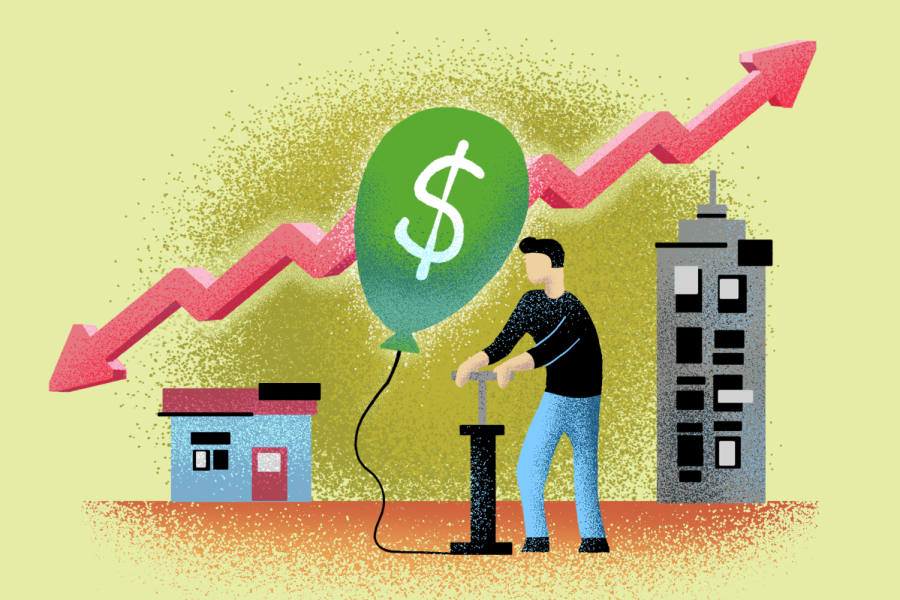Firing Lane: Inflation continues to hurt local businesses while corporations prosper
With recent fluctuations of inflation, it has affected how consumers support businesses. This illustration depicts a balloon with a dollar sign being pumped along with arrows indicating growth for larger businesses while smaller businesses decline.
April 18, 2023
In just a short amount of time David Kell, a restaurateur in Corvallis, has seen the price of a 20-lb case of shredded iceberg lettuce rise from $22 dollars and peak at $65 dollars.
Julie Littman, senior reporter at Restaurant Dive reported that the menu prices of dine-in restaurants rose 8.8% while fast-food menu prices rose 7.1% in September year-over-year. Rising operating costs, supply chain issues and higher wages are causing restaurateurs to increase their prices.
While consumers are becoming more cost-conscious when eating out, local businesses like University Hero say they’re doing what they can to survive.
Kell bought University Hero in July 2022, about nine months ago. Before buying the 40-year-old business, he spent 26 years serving customers in the postal service.
“I love taking care of customers,” Kell said.
Kell’s love for the restaurant industry is a driving force behind his determination to persevere through the pandemic, and now inflation, with a recession being a growing fear.
According to Kell, the truck driver who delivers to his business informed him that multiple bars that he also delivers to, in the Eugene area, had to shut down due to rising costs, with an uncertainty whether the decisions were temporary or permanent.
Starbucks, however, doesn’t share the same fear and uncertainty, compared to the locally-owned businesses and franchise owners.
Derek Ettel, former interim-manager at the Starbucks in downtown Corvallis, said that the store did increase their prices, but it would be hard to pinpoint how much with an exact percentage.
However, CBS News reported that from 2021 to 2022, Starbucks has raised their prices at least 20%. A venti-sized cup of coffee was only $2.45 in 2021, but rose to $2.95 in 2022.
Ettel also said that even with inflation the store still stays busy, and even more so around holidays like Christmas. According to him, revenue from the store has continued to increase, but whether or not that’s due to customer sales or higher prices is unclear.
Even though customers aren’t shy to complain about the price changes, Ettel says that it doesn’t seem to slow down their spending habits on Starbucks coffee.
However Galatea Smith, a sophomore at OSU, says she seldom drank Starbucks, if ever, because she found it too expensive. She makes coffee at home instead.
“I mainly just like Thai food and coffee places,” Smith said through email. “I still get Thai occasionally but now I make coffee at my apartment.”
Smith began noticing prices rising around the fall of 2022. Even though inflation hasn’t stopped her from eating out, she said that it definitely slowed her down.
Before, she would only spend around $40 per week, but now she spends a more conservative $15 each week.
“I used to not pay as much attention but now I check prices on everything especially at the grocery store,” Smith said.
According to her, she makes an effort to buy the cheapest items when shopping, which has resulted in her eating less meat and dairy products.
She has always been a fan of coupons but since 2022 she has made more of an effort to look out for her favorite ones.












































































































